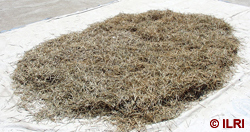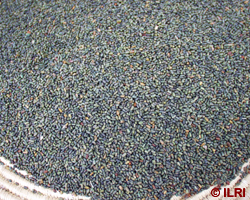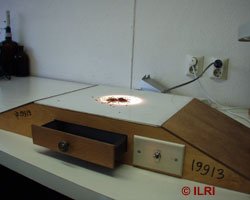Sample processing of forage legume genetic resources
Contributors to this page: ILRI, Ethiopia (Jean Hanson); ICARDA, Syria (Ahmed Amri, Kenneth Street, Ali Shehadeh, Natalya Rukhkyan); GRCTPL, Australia (Richard Snowball); Bioversity International/ILRI, Addis Ababa, Ethiopia (Alexandra Jorge).
|
Contents: |
This is the removal of physical contaminants from plant materials after harvesting, before storage. Legume seeds are hard and there is no physical damage during cleaning. All contaminants should be removed because of space constraints and costs of storage.
Legume pods should be threshed and cleaned immediately after harvest or soon after they arrive at the genebank to avoid infestation with bruchid insects. Many legume pods are dehiscent and open readily during drying when spread out in thin layer with sufficient air circulation.
|
Drying pods of forage legumes before threshing (photo: ILRI) |
- Seeds of Stylosanthes and Desmodium are firmly attached to pods and require threshing to extract the seeds.
- Threshing should be done when seed moisture content is between 12% and 16% to minimize injury to the seeds.
- Pods can be air dried by spreading in a thin layer in the shade before threshing to dry seeds.
- Hand threshing is preferred to avoid damage to seeds during the threshing process. Small quantities of pods can be rubbed gently with the hands or on a rubber threshing pad to remove the seeds.
- For larger quantities of pods, thresh by placing them in cloth bags or sacks or spreading them on a canvas and beating with a rubber hose or stick.
-
When using mechanical threshers, carefully clean with a brush or air blower between lots to:
- Avoid contamination with seeds of accessions previously threshed; and
- Prevent diseases and pests from being passed from one accession to another.
- The cleaning should be done using air blowing machines or hand cleaning.
|
|
|
|
From uncleaned sesbania seeds (left) to clean sesbania seeds (right) (photos: ILRI) |
|
Visual inspection of seeds (final hand cleaning)
Visual inspection is essential in genebanks to reach high standards of removing debris, including empty or infected seeds, needed for long term storage. This is also important to check and prevent further spread of insect and fungal damage.
According to the International Seed Testing Association rules, the following steps should be followed:
- Spread the seeds on a flat well lit surface of contrasting color.
- An illuminated table can be used if available.
- Examine dry seeds with the naked eye or under a binocular microscope (this method reveals free moving insects, larva and eggs, mites, fungal fructifications, bacterial masses, infected plant debris).
- Examinations under or near ultraviolet reveals infections of certain fungi and bacteria through emission of fluorescence.
|
Light box used for visual inspection of seeds |
Separating seeds on a flat lit surface |
For insect and fungal damage
- Isolate the infested/infected samples.
- Destroy samples when quarantine diseases and/or insects are observed.
- Otherwise clean the seeds before storage using fumigation to control insects.
For mechanical damage and empty seeds
- Manually clean shriveled and damaged seeds.
|
|
Special treatments
- If infested with insects, place seeds in a deep freezer for 3 days.
- There is no information on the effects of agrochemicals on longevity during storage in genebanks, so it is better to avoid them. This is also better for staff health and safety.
- Fumigate with agrochemicals when the previous option is not possible.
Disposal of contaminated materials
- Incinerate or autoclave contaminated materials, to avoid spreading diseases and pests and destroy infected materials by burning.
Inspection and certification (purity analysis of seeds)
- This should be done according to International Seed Testing Association rules, following their standard methods (see purity analysis).
Recording information during seed cleaning
The following information should be recorded for each processing step:
- Accession number (an ID number).
- Lot number (an ID number).
- Seed weight (weight of seeds for storage).
- Reference to seed source (to trace the origin of the sample).
- Flags (Y/N) indicating completion of steps mentioned above (checking).
- Remarks.
Seed drying
Method recommended in genebank standards
- Use a dehumidified drying room with 13-15% relative humidity and 20-25oC.
- A relative humidity of 13-15% is however sometimes very hard to achieve. A relative humidity up to 25-30% can also be used, but it will prolong the drying period.
- The seed samples should be kept in paper, mesh or cotton bags on mesh racks during the drying period.
Drying time:
- Depending on seed size, from 2-8 weeks.
- The lower the relative humidity the faster the seeds will dry.
Moisture content before drying:
- Depending on seed size and seed coat, 8-12%.
- Up to 20% for Lupinus spp.
Moisture content for storage:
This is recommended in genebank standards (FAO/IPGRI, 1994) and experience shows that seeds remain with high viability for >20years, when using this standard.
- In general should be around 5% +/- 2%.
- Except for soybean that should be not less than 8%.
Critical moisture content:
The critical moisture content is the level below which further reduction in moisture content no longer increases seed longevity in low temperature storage. Critical moisture content values vary with storage temperature and species. For more information see Rao et al, 2006.
- It is recommended for most of the crops not to dry below 3% to avoid any adverse effects on the seed texture and viability. However, recent findings are suggesting drying to 2% to extend storage period.
-
It is recommended to dry to about 3-4% for some temperate forage legumes.

Seeds drying in a mesh bag (photo: ILRI)
Recording information during seed drying
The following information should be recorded for each processing step:
- Accession number (an ID number).
- Lot number (an ID number).
- Seed weight (weight of seeds for storage).
- Reference to seed source (to trace the origin of the sample).
- Flags (Y/N) indicating completion of steps mentioned above (checking).
- Remarks.
Determination of seed moisture content
Methods
Sampling frequency
|
Seed moisture determination (photo: ILRI) |
Standard drying periods under the drying conditions available in the genebank have been determined and so it is only necessary to measure moisture content on sample accessions once.
- Sample once at end of drying period to determine moisture for storage.
- Random sample during storage, in case there are holes in the bags.
Calculate seed moisture content by weight loss on a wet weight basis.
Sample size
This method follows a modified ISTA 2005 method using more replicates of smaller weight of seeds.
- Take 1.0-2.0g (0.25-0.5g for small seeded species) from each sample as two independent replicates.
Pre-drying
Pre-drying is obligatory if seeds are wet and their moisture content is suspected to be above 17% (10% for soybean and 13% for rice); it should be conducted prior to moisture content determination by oven-drying.
If pre-drying is required, proceed as follows:
- Weigh two sub-samples of 4-5g of seeds in their containers.
- Pre-dry the samples overnight in a warm, dry place such as a laboratory bench.
- Weigh them again in their containers and determine the loss of weight (loss of moisture) by subtraction.
-
Calculate the moisture content on a fresh-weight basis.
Grinding
Grinding is recommended for large seeded species (about 2-3 mm) to ensure small particles for efficient removal of moisture.
- Coarse grinding the sample using an adjustable mechanical grinder.
Species for which grinding is obligatory (ISTA, 2005):
|
Arachis hypogaea Avena spp. Cicer arietinum Citrullus lanatus Fagopyrum esculentum Glycine max |
Gossypium spp. Hordeum vulgare Lathyrus spp. Lupinus spp. Oryza sativa Phaseolus spp. |
Pisum sativum Secale cereale Sorghum spp. Triticum spp. Vicia spp. Zea mays |
Oven drying temperature
This is another standard and proven method, and the best practice is to follow the ISTA (2005) suggested methods.
Recording information during determination of seed moisture content
The following information must be recorded for each processing step:
- Accession number (an ID number).
- Lot number (ID number).
- Taxonomic identification.
- Date of test (the date that the test was commenced).
- Method (name of standard method).
- Drying temperature (oven temperature).
- Fresh weight in grams (weight of sample per replication).
- Dry weight in grams (weight of sample per replication).
- Moisture content (percentage moisture content after drying).
References and further reading
FAO/IPGRI. 1994. Genebank standards. Food and Agriculture Organization of the United Nations, Rome and International Plant Genetic Resources Institute, Rome. Available in English, Spanish, French and Arabic.
ISTA. 2008. International Rules for Seed Testing. International Seed Testing Association. ISTA secretariat, CH-Switzerland. Available from: www.seedtest.org/.
Rao NK, Hanson J, Dulloo ME, Ghosh K, Nowel D, Larinde M. 2006. Manual of seed handling in genebanks. Handbooks for Genebanks No. 8. Bioversity International, Rome, Italy. Available in English (1.5 MB), Spanish (1.4 MB) and French (1.9 MB).
Comments
- No comments found












Leave your comments
Post comment as a guest